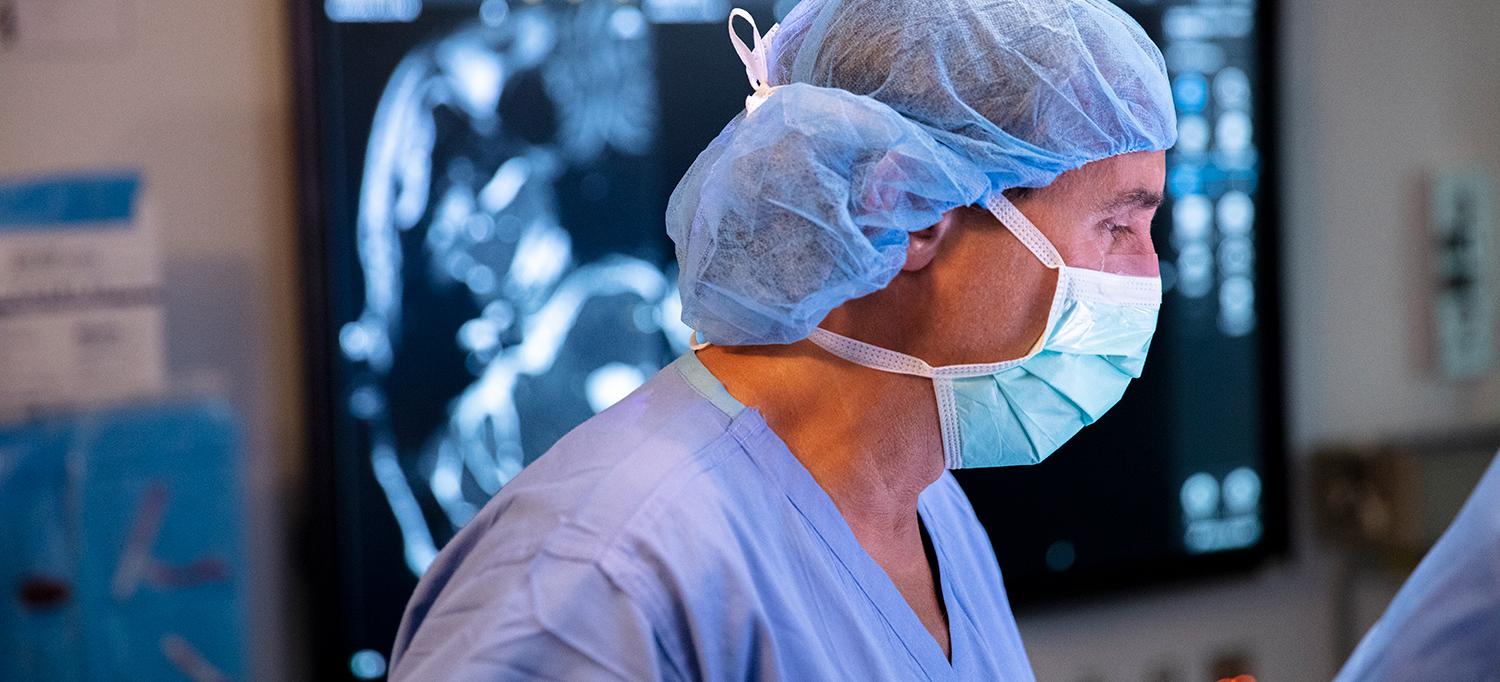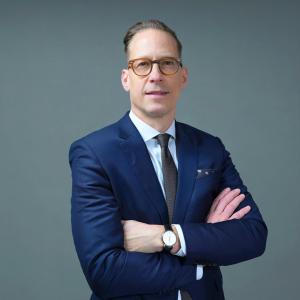
Members of NYU Langone’s Department of Neurosurgery, led by Dr. John G. Golfinos, discuss the responsibility of treating the organ that makes us who we are.
Photo: NYU Langone Staff
It’s taken hours of painstaking work—prepping, cutting, sawing, drilling, and clamping—to get here, but John G. Golfinos, MD, has finally reached his destination: the first of two benign tumors he’ll be removing from the patient’s brain. During an especially delicate part of the procedure, he shares a piece of wisdom, born of 17 years of experience as a lead surgeon, with his assisting surgeon, a seventh-year resident. “Now, when you get to this part,” he says quietly, peering through the eyepieces of a large overhead microscope, “you have to have the courage to cut.”
The courage to cut. The phrase goes to the heart of what it means to be a neurosurgeon, and what makes neurosurgeons a breed apart. “Sometimes you face a tough decision,” explains Dr. Golfinos, the Joseph Ransohoff Professor of Neurosurgery, professor of otolaryngology, and chair of the Department of Neurosurgery. “Either I try to remove every last bit of this tumor, or I leave some behind. Most of the time, the tumor will keep growing. But if you try to get it all, there’s often a cost to the patient. You’re constantly doing risk–benefit analysis. That’s why you have to know the patient as well as you can. You must have a sense of what he or she would be willing to sacrifice to extend their life. I’m amazed at how much more aggressive I was just 10 years ago. As you get older, all the complications and consequences start to weigh on you.”
Dr. Golfinos and his colleagues in the Department of Neurosurgery are ever mindful of their unique, profound responsibility: treating the organ that, more than any other, makes us who we are. “From the brain and the brain only,” noted Hippocrates, “arise our pleasures, joys, laughter, and jests, as well as our sorrows, pains, grief, and fears.” Chandra Sen, MD, professor of neurosurgery and director of the Division of Skull Base Surgery, speaks of “the sacred privilege” of being a neurosurgeon. “When I first meet a patient, that person has never seen me before, yet he or she is willing to put their life in my hands. This is the weakest moment in that person’s life—they are lost, helpless, scared to death. I have to treat this person very gently. I never take the risk. It’s the patient who takes the risk. He or she must have courage. I must have conviction. Before a big case, I meditate. It gets my mind in the zone.”
That gentleness, says Dr. Sen, must carry over into the operating room (OR). “The brain has the consistency of Jell-O. A tumor feels like a piece of meat. The nerves are like small wet noodles,” he explains. “You must peel away the meat without disrupting the Jell-O. Along the way, you must be careful not to damage any blood vessels, which could cause a stroke, or nerves, which could cause blindness, deafness, paralysis, or other problems. To succeed, you must have a gentle touch—and the heart of a lion. Once you are done with the operation, the brain must never know you were there.”
Is it any wonder that neurosurgeons speak so reverentially of this three-pound mass of pinkish-gray tissue about the size of a cantaloupe? “The brain is the most complex organ in the universe,” says Jafar J. Jafar, MD, professor of neurosurgery and neurosurgeon-in-chief at NYU Langone’s Tisch Hospital. “We still don’t know which part of the brain we see with. It’s an enduring mystery—one of many enduring mysteries.” Dr. Golfinos puts it another way: “We can operate on someone’s brain while they’re awake, take out part of it, and they can talk to us the entire time. Even though we’re actually damaging a small part of the brain, the rest of it couldn’t care less.”
The marvels of the human brain don’t end there, of course. An organ whose makeup is 75 percent water, it generates 100,000 chemical reactions every second and enough electrochemical energy to power a 10-watt lightbulb. The brain contains 100 billion neurons (nerve cells), each connected—directly or indirectly—to as many as 100,000 others. Twelve pairs of cranial nerves, some of which control numerous parts of the head, and 100,000 miles of blood vessels crisscross its terrain. Though pain is registered in the brain, the organ itself has no pain receptors and cannot feel pain. The brain demands 15 to 20 percent of the blood pumped from the heart. If it’s deprived of blood-borne oxygen for as little as 8 to 10 seconds, the result is unconsciousness. After 30 seconds or so, permanent brain damage may occur. In a single day, the brain gives rise to an estimated 70,000 thoughts, processing information at a rate of up to 268 miles per hour. In a lifetime, it can retain 1 quadrillion separate bits of information.
Such a precious object deserves high-level security, and the brain’s protective mechanisms are truly impressive. The bony skull, or vault, is a quarter-inch thick at the top and even thicker at the base. The meninges, three layers of membranes that line the skull, shield the brain further. The brain is suspended in cerebrospinal fluid, which functions as a shock absorber, reducing the impact of sudden blows. Isolated from the bloodstream by a blood–brain barrier, the brain has a dutiful gatekeeper, admitting some nourishing elements and forbidding entrance to others, notably toxins.
The challenge of penetrating this formidable fortress to reach the treasure that lies within has intrigued mankind for centuries. The first successful operations to remove tumors, however, took place only about a century ago. Until the 1970s and 1980s, when CT scans, overhead microscopes, high-intensity illumination in the OR, and microsurgical instruments became available, a neurosurgeon’s skill relied largely on his keenness of vision and steadiness of hand. While manual dexterity, hand–eye coordination, spatial perception, and tactile memory (the ability to return your hand to exactly the same place it was before you moved it) will always be the hallmarks of a neurosurgeon, “golden hands have become less and less important,” says Jeffrey H. Wisoff, MD, professor of neurosurgery and pediatrics, and director of the Division of Pediatric Neurosurgery. “Before we had the benefit of detailed imaging, stereotactic navigation, and electrophysiological monitoring, you had to have incredible technical mastery,” he explains. “That said, you can’t be a klutz.”
Then what does separate good neurosurgeons from great ones? “The greats have a real balance of confidence and empathy,” Dr. Golfinos says. “The hardest thing to teach is taking ownership of the patient—realizing that this person has placed everything they have in your hands.” Dr. Sen agrees: “If you exude a lack of confidence, your entire team senses it, and the team breaks down. If you get anxious, your hand shakes, and the situation quickly deteriorates.” For Dr. Wisoff, the key is strategy. “You plan an operation like you plan a battle,” he says. “You know where all the pieces lie, and you’re prepared for as many contingencies as possible.” Dr. Jafar sums it up in a single word: tenacity. “Hating to lose is what makes us a breed apart. I chose neurosurgery because it’s difficult. I thrive on challenges. I’m a bad loser.”
NYU Langone’s Department of Neurosurgery has never had so many winners. Dr. Golfinos has recruited several outstanding neurosurgeons, some of them world renowned for their expertise in subspecialties. The department now has 17 neurosurgeons serving patients at Tisch Hospital, Kimmel Pavilion, NYC Health + Hospitals/Bellevue, and the Manhattan campus of the VA NY Harbor Healthcare System. Its long-standing reputation for excellence encompasses surgery for brain tumors, brain aneurysms and vascular malformations, spine ailments, epileptic seizures, Parkinson’s disease (treated with deep brain stimulation), and a range of other conditions.
“Some of our colleagues are iconic,” says Anthony K. Frempong-Boadu, MD, associate professor of neurosurgery and orthopedic surgery and director of the Division of Spinal Surgery. “We observe each other in the OR like it’s our first time there. The intellectual exchange has upped everyone’s game.” Dr. Jafar is so proud of his newly expanded department that he says, “I’ve visited many departments of neurosurgery around the world, and few of them rival ours. Many patients are told that their tumor is inoperable, but then they come here and they survive.”
“Our goal,” Dr. Golfinos says, “is to be the place that other neurosurgery centers refer their really difficult cases to because we can get the job done.” For neurosurgeons, that often requires what Dr. Frempong-Boadu describes as “walking the tightrope” between confidence and hubris. “Neurosurgeons are comfortable going into the unknown,” he says. “A lot of what we do is shrouded in mystery. What makes a great neurosurgeon is their thinking. It’s not about technical skills. It’s about knowing what you can and can’t touch, what you can and can’t move. A great neurosurgeon can almost see through things.”
For all the information and insights that sophisticated imaging can provide, the map is not the same as the territory itself, and danger, if not disaster, is sometimes only a millimeter away. “You’re often working in a surgical field the size of a quarter or half-dollar,” Dr. Wisoff explains. “If you don’t have fear,” adds Dr. Jafar, “you’re dangerous. You can work for hours, and in the last 10 seconds, you can ruin everything. The most dangerous part of the operation is the last five minutes because you think you’re finished. You can’t afford to let your guard down, even for a moment. I don’t listen to music while I’m operating. The night before, I listen to Mozart. In the OR, I’m listening to the patient’s heart rate, one of many things that guide me.”
The importance of total concentration is just one of the lessons Dr. Jafar tries to instill in his residents, mostly by example. Unlike many programs in neurosurgery, NYU Langone has a training period of seven years instead of six. During the last year (the second of 2 as chief resident), the newly minted neurosurgeon functions as the operating surgeon for more than 300 varied neurological procedures. Yet there’s one thing, says Dr. Jafar, that you can’t teach: judgment. “For a neurosurgeon,” he explains, “common sense is knowing what your limits are. Knowing how to stay out of trouble—or get yourself out of trouble. Knowing when to stop the surgery if you have to.”
Dr. Wisoff feels that the key to mastering the art of critical thinking inside the OR is to anticipate as many pitfalls as possible and carefully consider the options outside the OR. “When you’re removing a malignant tumor,” he says, “you have to be appropriately aggressive. If you go in with a timid attitude, you’ll perform a timid operation—what we call peek and shriek. If that’s not right for the patient, you’ve done him or her a tremendous disservice.” In the still fairly uncharted landscape of the brain, doing what’s right for the patient may be the greatest challenge of being a neurosurgeon, but it’s also the most critical. “If I’m not comfortable with a resident I’ve trained operating on a member of my own family,” Dr. Jafar says, “then I’ve failed.”
For even the best neurosurgeons, the possibility of failure—be it deficits or death—always looms large. “Every one of my cases is my toughest case ever,” Dr. Sen says. “That degree of respect keeps you from becoming cavalier.” The survival rates for benign brain tumors have increased dramatically over the years, so most of the time, notes Dr. Jafar, “the odds are by far in favor of the patient.” In children with malignant brain tumors, explains Dr. Wisoff, the cure rates are above 80 percent. “I followed in my father’s footsteps,” he explains, “and he taught me that to be a neurosurgeon, you have to be an optimist. ‘Maybe it’s a subdural hematoma that we can drain and cure the patient,’ he would say. Or ‘Maybe it’s a benign tumor that we can remove and cure the patient.’ Or ‘Maybe it’s a low-grade malignancy that will allow us to buy the patient a lot of time.’ Or ‘Maybe we can’t save the patient, but we can bring better quality to their life.’”
“Some patients have a will to live that’s very, very strong,” Dr. Golfinos notes, “especially if they have children or someone else to live for.” But on those rare occasions when a neurosurgeon must accept defeat—and they can recite the names of every patient they’ve ever lost—the toll is a lingering one. “When my kids were young,” Dr. Wisoff recalls, “I would go home and give them a big hug. Then I’d sit down with my wife and have a long talk.” For Dr. Sen, healing requires solitude. “When I have a disaster,” he says, “I go home, I sit quietly, and I have even cried.” Dr. Jafar believes that the only true measure of comfort comes from “knowing that you did your best, and that you’re at peace with yourself.”
Neurosurgeons seem to reserve their greatest optimism for their faith in nature and science. “When you think of the billions of cell divisions that take place between conception and delivery,” says Dr. Wisoff, “creating the potential for our genetic code to be misinterpreted or to go awry, it’s astonishing how few problems we actually have.” Dr. Golfinos points to improved medications, endovascular techniques, technology, and other advances that have “stacked the odds in our favor.” About 50 years ago, he reminds us, “there was only one kind of tumor that could be removed without killing the patient: a meningioma. Fifty years from now, the greatest advance will be the elimination of neurosurgery. Our specialty will probably be obsolete.”

